Need weekend plans?
The best things to do around the city, delivered to your inbox.
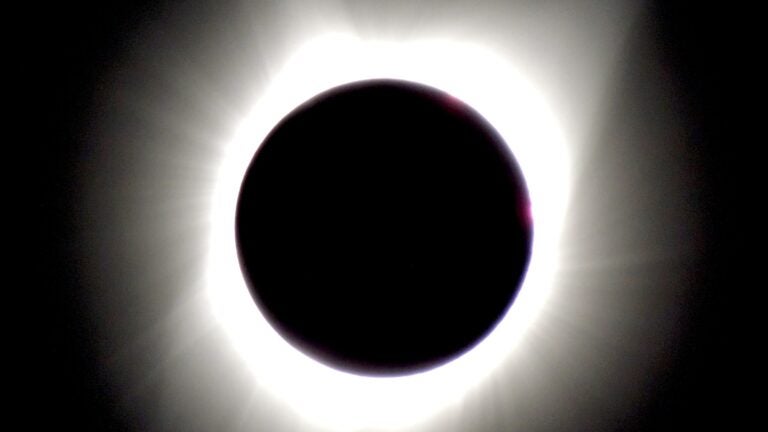
On Monday, April 8, tens of millions of people across the United States will look skyward to witness the 2024 solar eclipse. For more than two hours, the moon will slowly obscure more and more of the sun from view. Certain parts of the country will even be able to view a 100% total solar eclipse for around three minutes.
For the first time since 2017, the solar eclipse’s path of totality — the viewing area where the sun will be 100% obscured by the moon — crosses a large swath of the entire continental U.S. In total, the 2024 solar eclipse path of totality crosses 15 states: Texas, Oklahoma, Arkansas, Missouri, Illinois, Kentucky, Indiana, Ohio, Pennsylvania, New York, Vermont, New Hampshire, Maine, and very small parts of Tennessee and Michigan.
As someone who trekked all the way to Idaho to be in the path of totality during the 2017 total solar eclipse, I can assure you that a 100% total solar eclipse is one of the most awe-inspiring, transcendent experiences you can have on this planet.
The temperature drops rapidly, the sky goes pitch black, the birds start losing their minds, and for the briefest moments, the massive ball of gas responsible for all past, present, and future life on this Earth is extinguished.
Bostonians will experience a 92.55% eclipse, a significant step up from the 63% eclipse the city saw in 2017. But if you’re able, it’s absolutely worth the time and effort to head north and get as close to the 100 percent total solar eclipse experience as possible.
It will be more than 20 years until the next total solar eclipse’s path of totality touches the continental U.S., meaning this is many people’s best chance to experience a celestial event that is unrivaled by any other — even the Northern Lights.
To help you make the most of the 2024 solar eclipse — whether you’re staying in Boston or traveling elsewhere in New England — we’ve compiled a full guide of everything you need to know ahead of time.
What time does the eclipse start in Boston? Where are the best towns in New England to see a total solar eclipse? How can I buy eclipse glasses that offer safe eye protection? These questions and more are answered below, offering readers a one-stop hub for eclipse information.
Here is everything you need to know for the 2024 solar eclipse, particularly as it pertains to Boston, the rest of Massachusetts, and towns in the path of totality across New England.
Click the links below to jump directly to the following information:

The solar eclipse will be visible across the continental United States. If you want to see a total solar eclipse, in which 100% of the sun is obscured by the moon, New Englanders will need to be in New Hampshire, Vermont, or Maine.
In Boston, viewers will see 92.55% of the sun eclipsed by the moon. The obscuration percentage increases the closer you get to the path of totality, even just by crossing the river into Cambridge (92.67%).
Like the rest of New England, the duration of the 2024 solar eclipse — the total amount of time that any part of the moon is obscuring the sun — will be around two and a half hours. To simplify things, here is a list of some notable cities in Massachusetts, the obscuration percent, what time the partial eclipse starts and ends, and when the “peak” eclipse will happen.
Don’t see your town or city listed? Check out NASA’s interactive tool tracking the solar eclipse path and timeline, searchable by town name or zip code.
Boston, Massachusetts
Eclipse percentage: 92.55%
Partial eclipse start time: 2:16 p.m.
Peak eclipse time: 3:29 p.m.
Partial eclipse ends: 4:39 p.m.
Lowell, Massachusetts
Eclipse percentage: 93.9%
Partial eclipse start time: 2:16 p.m.
Peak eclipse time: 3:29 p.m.
Partial eclipse ends: 4:38 p.m.
New Bedford, Massachusetts
Eclipse percentage: 89.7%
Partial eclipse start time: 2:16 p.m.
Peak eclipse time: 3:29 p.m.
Partial eclipse ends: 4:38 p.m.
Springfield, Massachusetts
Eclipse percentage: 93.4%
Partial eclipse start time: 2:13 p.m.
Peak eclipse time: 3:27 p.m.
Partial eclipse ends: 4:37 p.m.
Worcester, Massachusetts
Eclipse percentage: 93.1%
Partial eclipse start time: 2:15 p.m.
Peak eclipse time: 3:28 p.m.
Partial eclipse ends: 4:38 p.m.
In the New England states that are in the path of totality — Vermont, New Hampshire, and Maine — the partial eclipse timing is relatively the same as in Massachusetts. The westernmost points begin slightly earlier than 2:15 p.m., and the easternmost points begin slightly after. Those towns in the path of totality will enjoy around three minutes of 100% eclipse time, beginning slighter before or slightly after 3:30 p.m.
Here are a few specific times for three New England towns that are in the path of totality, according to NASA.
Burlington, Vermont
Partial eclipse begins: 2:14 p.m.
Total eclipse begins: 3:26 p.m.
Total eclipse ends: 3:29 p.m.
Partial eclipse ends: 4:37 p.m.
Lancaster, New Hampshire
Partial eclipse start time: 2:16 p.m.
Total eclipse start time: 3:27 p.m.
Total eclipse ends: 3:30 p.m.
Partial eclipse ends: 4:38 p.m.
Caribou, Maine
Partial eclipse start time: 2:22 p.m.
Total eclipse start time: 3:32 p.m.
Total eclipse ends: 3:34 p.m.
Partial eclipse ends: 4:40 p.m.
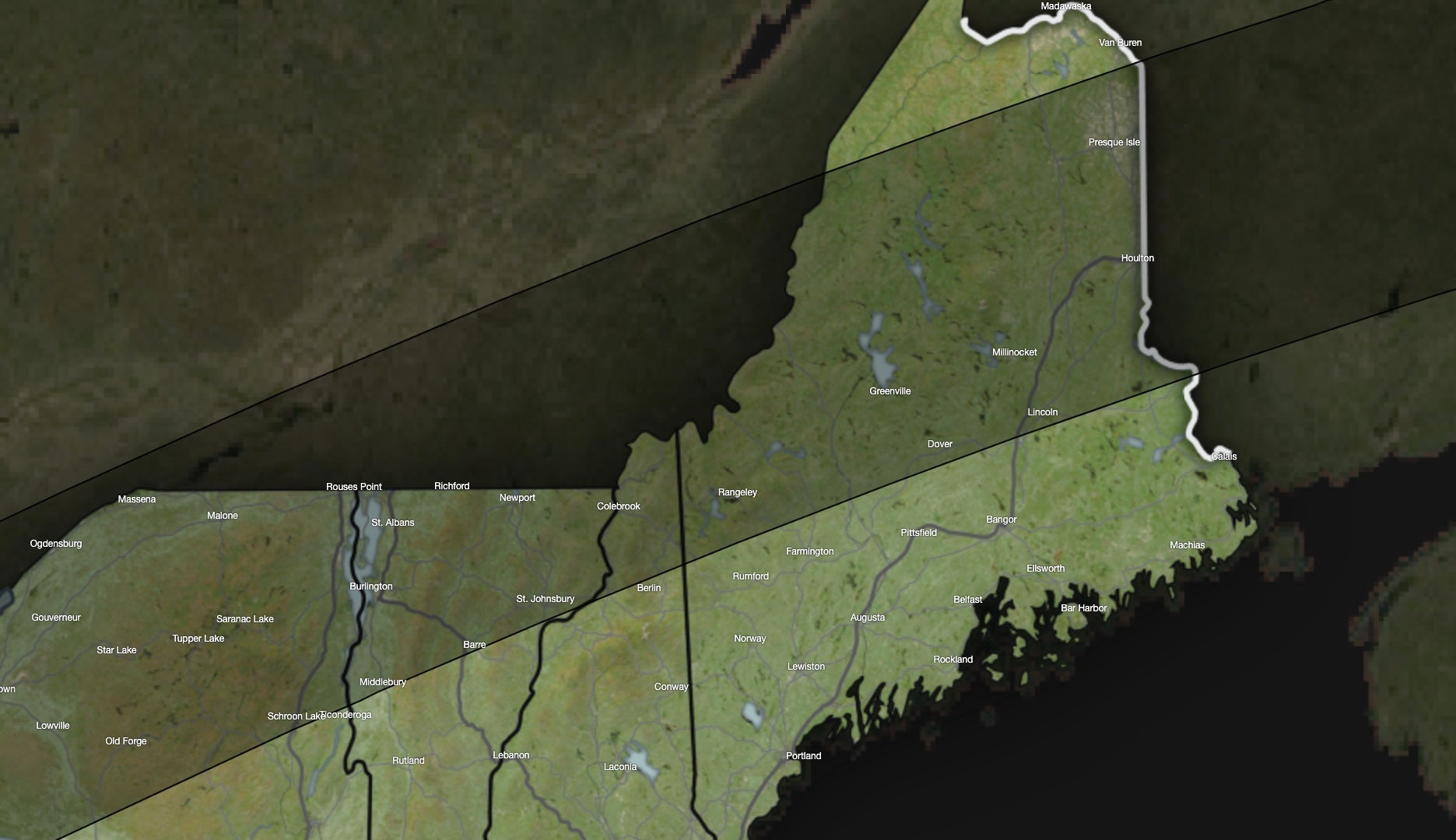
The 2024 solar eclipse path of totality crosses through the northern half of Vermont, a sliver of northern New Hampshire, and a large portion of Maine.
All three states have several towns you can visit to see a 100% total solar eclipse, but Vermont is probably your best bet. Several population centers such as Burlington and Montpelier are in the path of totality.
In his list of the best places to watch the 2024 solar eclipse, meteorologist Dave Epstein highlighted three towns in Vermont: St. Johnsbury, Burlington, and Barre. St. Johnsbury in particular is great for Bostonians, according to Epstein.
“The closest drive from Boston to totality is Vermont,” Epstein said. “In terms of significant towns, St. Johnsbury is your best bet — a straight shot up Route 91 in under three hours.”
Maine has more than 300 towns in the path of totality, but many are sparsely inhabited and relatively inaccessible by vehicle. There are some along I-95, however, so it is doable. Epstein highlighted Houlton, one of the last towns in the U.S. to experience the eclipse, and located right in the middle of the path of totality.
“In Maine, the small town of Houlton would give you around 3 minutes and 20 seconds of totality for an easy, but long drive up Interstate 95 from Boston,” Epstein wrote. “This would take you about 5½ hours to get to this community located just 4 miles from the Canadian border. If you left at 7 a.m., you’d have plenty of time to view the eclipse.”
New Hampshire, meanwhile, only has a handful of towns in the path of totality, which leaves slim pickings for visitors. Coleman State Park in Stewartston, which sits solidly in the path of totality, sold out its reserved parking spots months ago, according to a state official.
If you’re OK with slightly less than 100% total eclipse, tourist areas with more capacity include Cannon Mountain in Franconia (99.5%) and North Conway (98.5%).
Here is a partial list of towns in Maine, New Hampshire, and Vermont that are in the path of totality.
Maine: Caribou, Dover, Easton, Greenville, Houlton, Littleton, Millinocket, Monticello, Moosehead, Oxbow, Rangeley, Sherman, Smyrna
New Hampshire: Colebrook, Columbia, Lancaster, Pittsburg, Milan, Stewartstown
Vermont: Barre, Barton, Burlington, Essex Junction, Folsom, Greensboro, Hinesburg, Marshfield, Milton, Montgomery, Montpelier, Morristown, Newport, St. Albans, St. Johnsbury, Waterbury
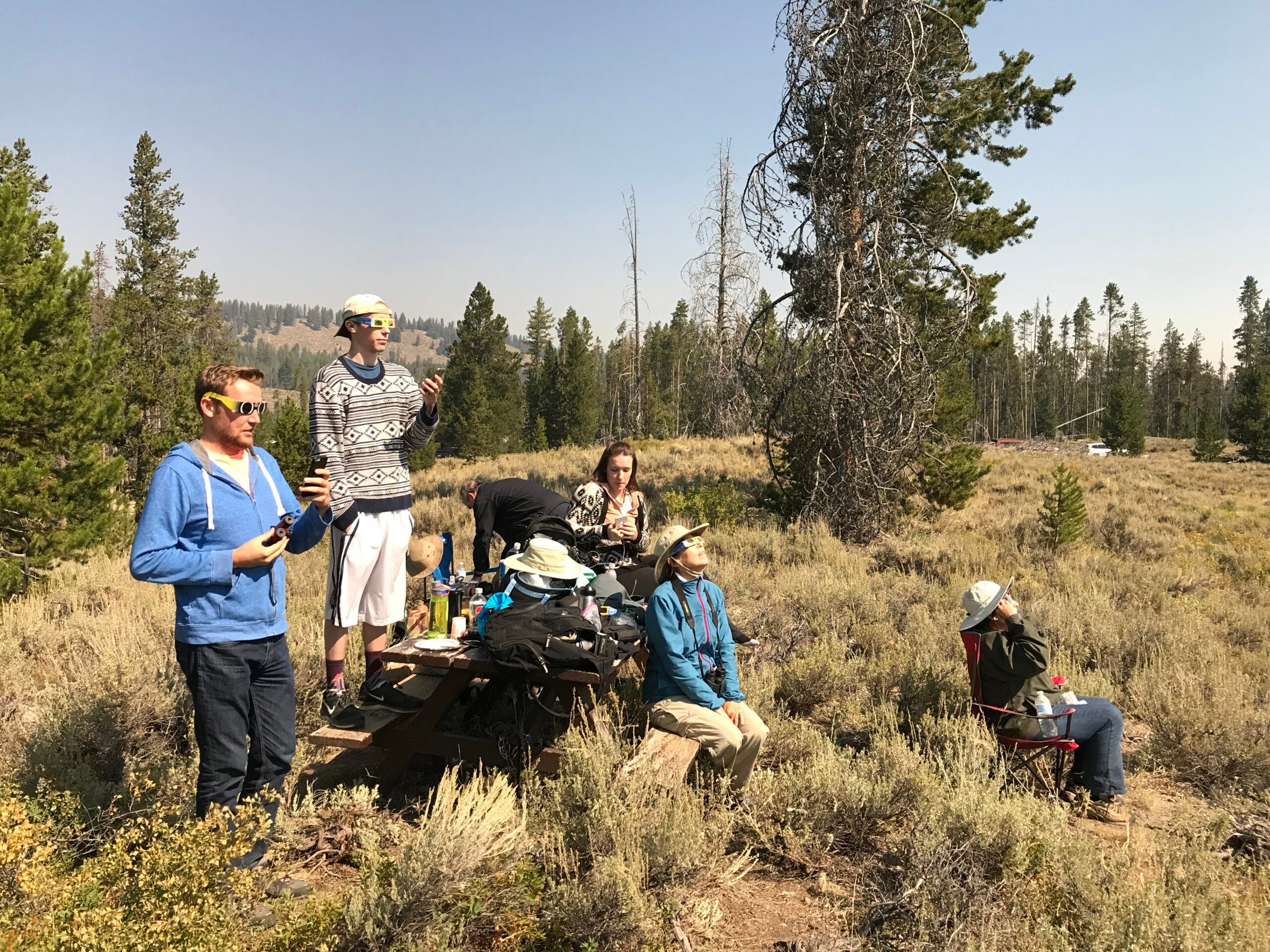
The tourism boards for Maine, New Hampshire, and Vermont have all been preparing for the 2024 solar eclipse for years now, offering attractive eclipse-themed vacation and getaway packages for visitors from all over the world. Eclipse enthusiasts have been preparing as well, which means that many popular ticketed events may be in short supply. Be sure to check on availability for the following events before making travel plans.
New Hampshire 2024 solar eclipse events include a “Special Eclipse Concert” at the Great North Woods Center for the Arts in Columbia and a ski eclipse party at Wildcat Mountain. To see a full list, check out the Visit NH solar eclipse page.
Many of Maine’s 2024 solar eclipse events are centered around Houlton, one of the last towns in the continental U.S. to experience the solar eclipse. The small border town is expecting around 40,000 visitors, and has four days of events planned for those staying for the long weekend. To see a full list, check out the Maine 2024 eclipse events page.
Vermont 2024 solar eclipse events include many in Burlington, the state’s most populous town. You can choose from a ticketed event at the town’s airport, an ’80s-themed “Total Eclipse of the Heart” event on the banks of Lake Champlain, and a number of events hosted by the fittingly named Obscura Burlington. To see more solar eclipse events in Vermont, check out Vermont Public Radio’s eclipse events round-up.
Massachusetts may not be in the path of totality, but you can still catch some pretty fantastic views in Boston and beyond. Pretty much every town we could find is hosting some sort of eclipse event, typically through the town library. Local businesses — especially those with roof access — are getting in on the action as well.
The state Department of Conservation and Recreation will host eclipse viewing events at eight state parks in Massachusetts, and will also provide free eclipse glasses and educational activities throughout Monday afternoon.
The events will take place at Blackstone River and Canal Heritage State Park in Uxbridge; Blue Hills Reservation in Milton; Borderland State Park in North Easton; Nickerson State Park in Brewster; Waquoit Bay National Estuarine Research Reserve in East Falmouth; Halibut Point State Park in Rockport; Great Falls Discovery Center in Turners Falls; and Mt. Greylock State Reservation in Lanesborough.
Eclipse viewing party locations in the greater Boston area include Central Library in Somerville, the main branch of the Cambridge Public Library, the Brighton branch of the Boston Public Library, Fresh Pond Reservation in Cambridge, the rooftop of the Revere Hotel in Boston, and discounted admission to View Boston.
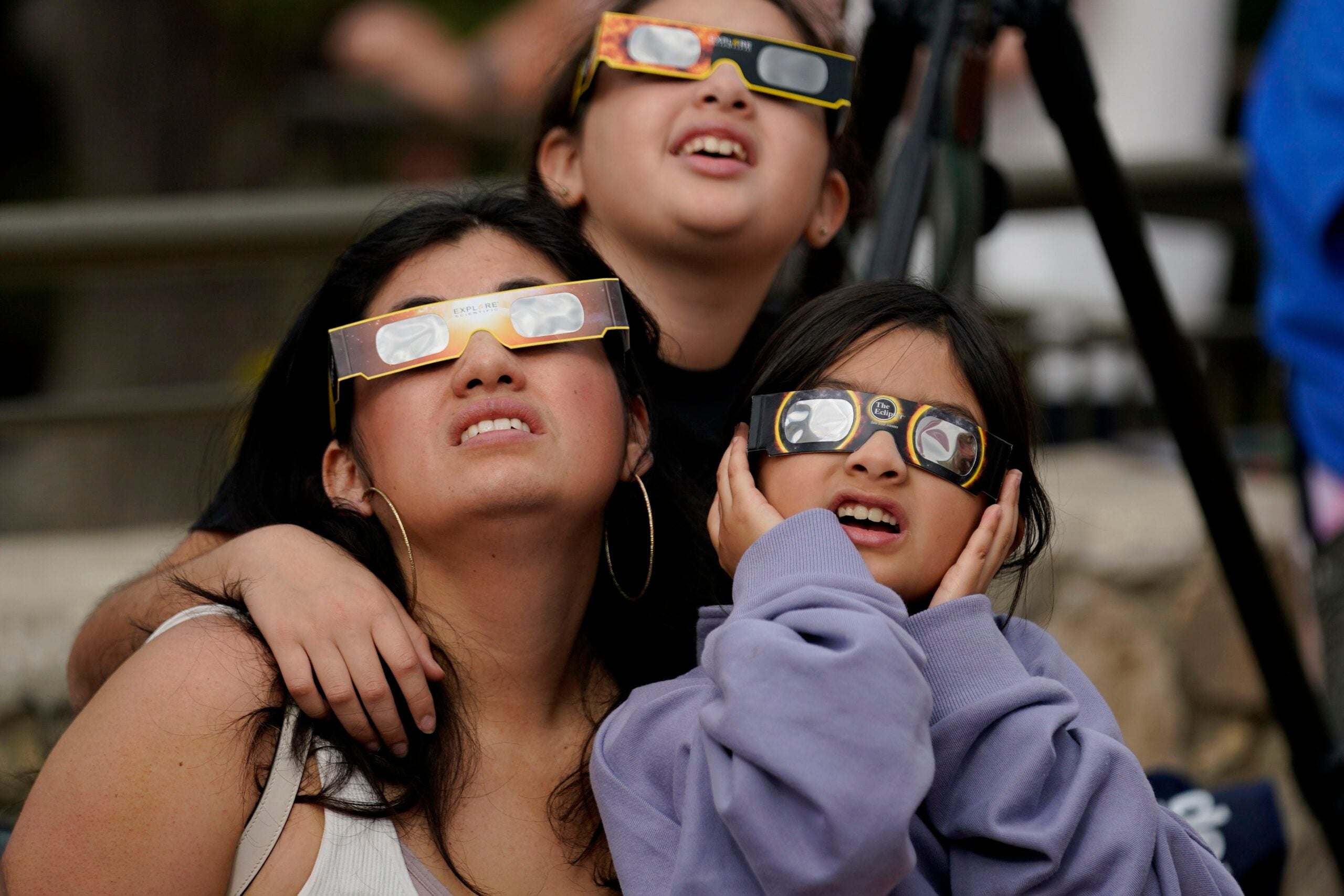
The weather is a major concern when watching the solar eclipse. Even a few clouds can alter the experience, and an overcast day is devastating.
Keeping in mind that the forecast in New England can change at a moment’s notice, the potential cloud cover on for the 2024 solar eclipse across New England looks promising.
In fact, as of Monday morning, New England is currently one of the only regions on the path of totality with a mostly clear forecast for Monday’s eclipse.
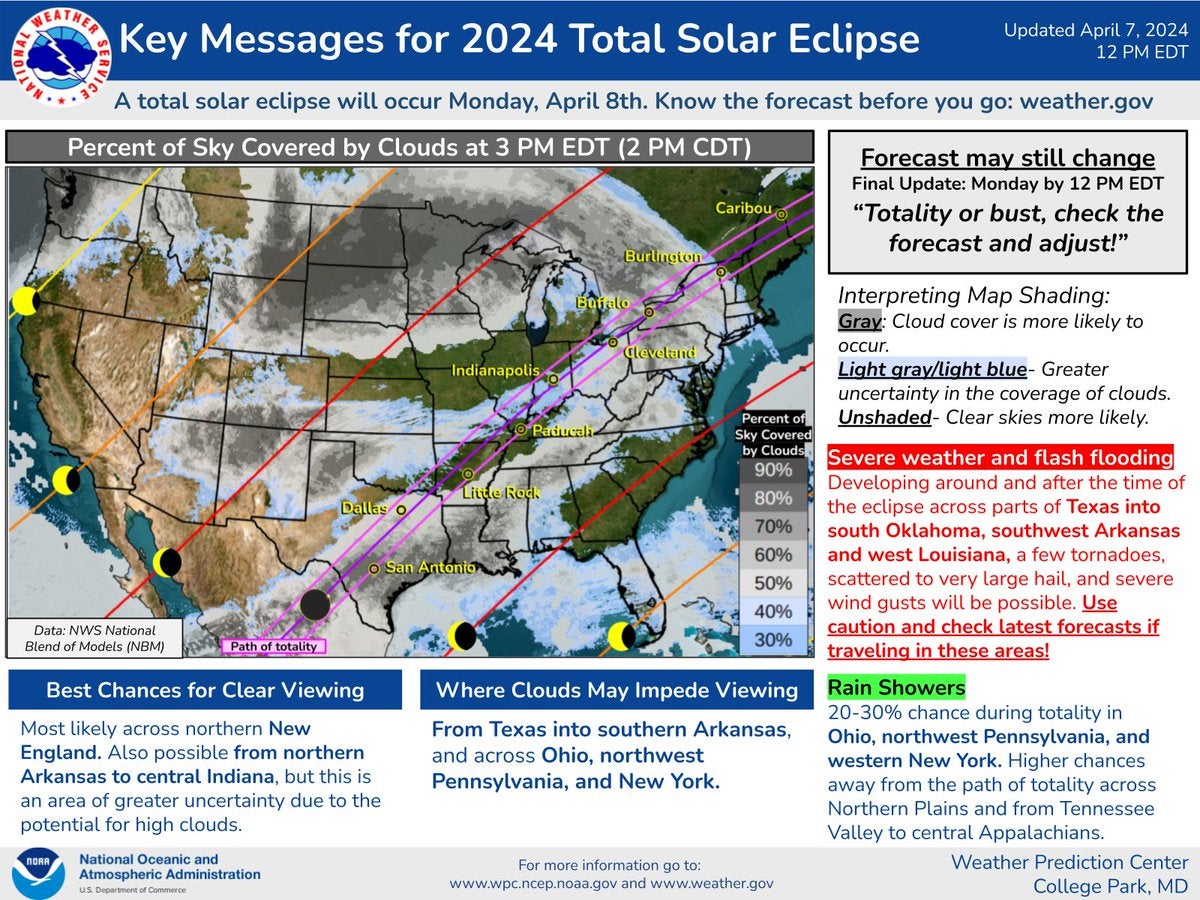
The National Weather Service currently predicts that most of New England will experience between 0 and 25% cloud cover on April 8, with Boston clocking in at just 19%.
Vermont, New Hampshire, and Maine all have great 2024 solar eclipse weather forecasts as well.
The NWS predicts high clouds in Western New England, including Burlington and Springfield, but believes they will be “thin and translucent, so conditions should remain favorable for viewing.”
Here's the forecast for Eclipse viewing across VT & northern NY on Mon. The latest trend is for HIGH clouds to come in a bit earlier, but they should be thin and translucent, so conditions should remain favorable for viewing. Please do so safely! pic.twitter.com/Ym0jrTzfCM
— NWS Burlington (@NWSBurlington) April 7, 2024
For the latest 2024 solar eclipse weather forecast updates, visit the Boston.com weather hub.
Solar eclipse glasses are a crucial accessory for viewing the 2024 solar eclipse, which means finding a pair may be tougher than you’d like. Hundreds of times darker than even the most tinted pair of sunglasses, safe eclipse glasses should be certified by the International Organization for Standardization or ISO 12312-2 international standard for filters.
According to the AAS, the best way to ensure that your eclipse glasses are safe is to buy from a list of approved online or physical retailers. Buying from a random listing on Amazon could lave you vulnerable to countereit glasses, which might not protect your eyes.
If you’ve already bought glasses from a third-party vendor, check out this list of ways to spot unsafe or counterfeit eclipse glasses from the AAS.
Here is a list of AAS-approved manufacturers for safe and ISO-certified eclipse glasses.
Additionally, here is a list of AAS-approved big-box retailers where you can buy eclipse glasses.
The simple answer is that no, you should not look at the eclipse without wearing eclipse glasses. The only exception to that rule is during the few minutes when the sun is 100% obscured by the moon.
Looking at the sun for any amount of time without proper viewing equipment can cause eye damage known as solar retinopathy. Burning the retinas can cause permanent eye damage, including scarring and blindness.
During a normal sunny day, we instinctively look away from the sun after a split second due to its brightness. During an eclipse, however, the sun is not as bright, which leads some people to mistakenly believe they can look at the sun for longer without risking eye damage.
The retina has no pain receptors, which means people who don’t know better, such as young children, may stare at the eclipse for minutes at a time without realizing the risk.
“You can stare at the sun during an eclipse for 10 minutes, and it doesn’t hurt. You can just look at it, and it’s really cool to look at it, but that whole time you’re literally burning the cells off your retina,” Vike Vicente, a Washington pediatric ophthalmologist, told the Washington Post. “And once they’re burned, there’s no repair, there’s no fix for it.”
Have you ever tried taking a picture of the moon with your phone? Almost impossible, right?
NASA recommends that anyone aiming to take the best photos of the 2024 solar eclipse use a DSLR camera because “smartphones were never designed to do sun and moon photography.”
For those who own a DSLR, Associated Press chief photographer Julio Cortez advises using a smaller aperture — f11 or f17 — to keep the focus “a little bit sharper.” When he shot the 2017 total solar eclipse, he used an ISO setting of 1250 and 1/500 shutter speed.
The American Astronomical Society also recommends using a solar filter to protect DSLR cameras against intense sunlight and heat.
For those stuck with just their smartphones, however, here are five tips to optimize your 2024 solar eclipse photos.
1. Some experts suggest HDR, or High Dynamic Range, mode, which takes a series of pictures at different light levels and then blends them into a single shot — ideal for combining an eclipse’s very dark and very bright areas.
2. Don’t use flash. You can spoil the moment by ruining the vision of those around you whose eyes have adapted to darkness.
3. For smartphones, you can use a spare pair of eclipse glasses and hold it over the lens in place of a solar filter. The AAS also has a list of solar filter attachments for smartphones.
4. Make sure macro mode is not on.
5. Whether using a smartphone or a DSLR, if you plan to shoot for an extended time, use a tripod.
Material from the Associated Press was used in this report.
The best things to do around the city, delivered to your inbox.
Stay up to date with everything Boston. Receive the latest news and breaking updates, straight from our newsroom to your inbox.
Conversation
This discussion has ended. Please join elsewhere on Boston.com